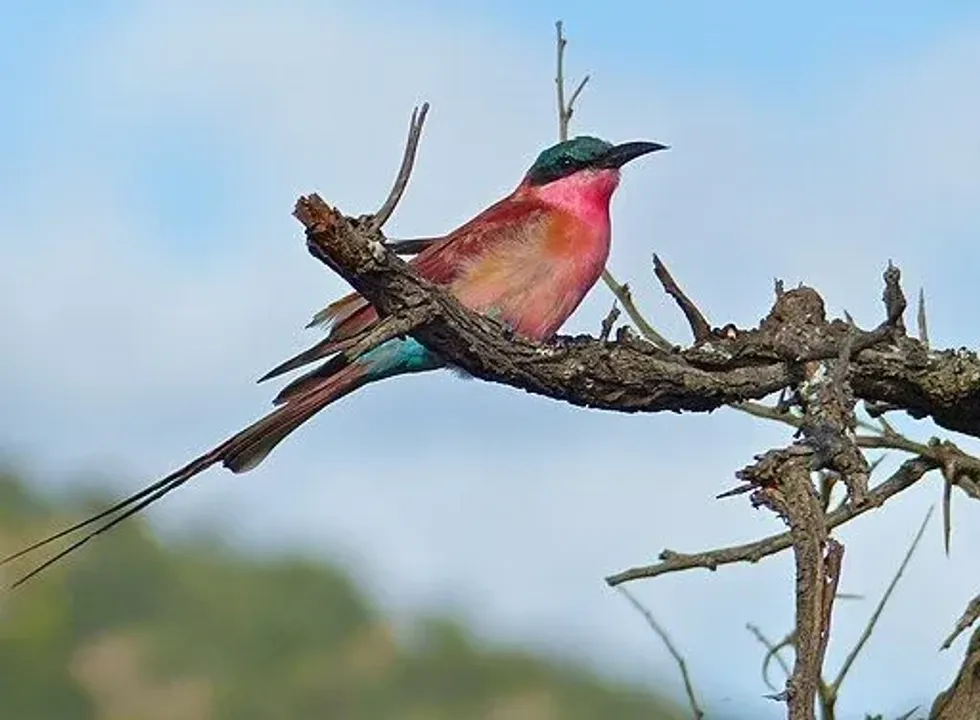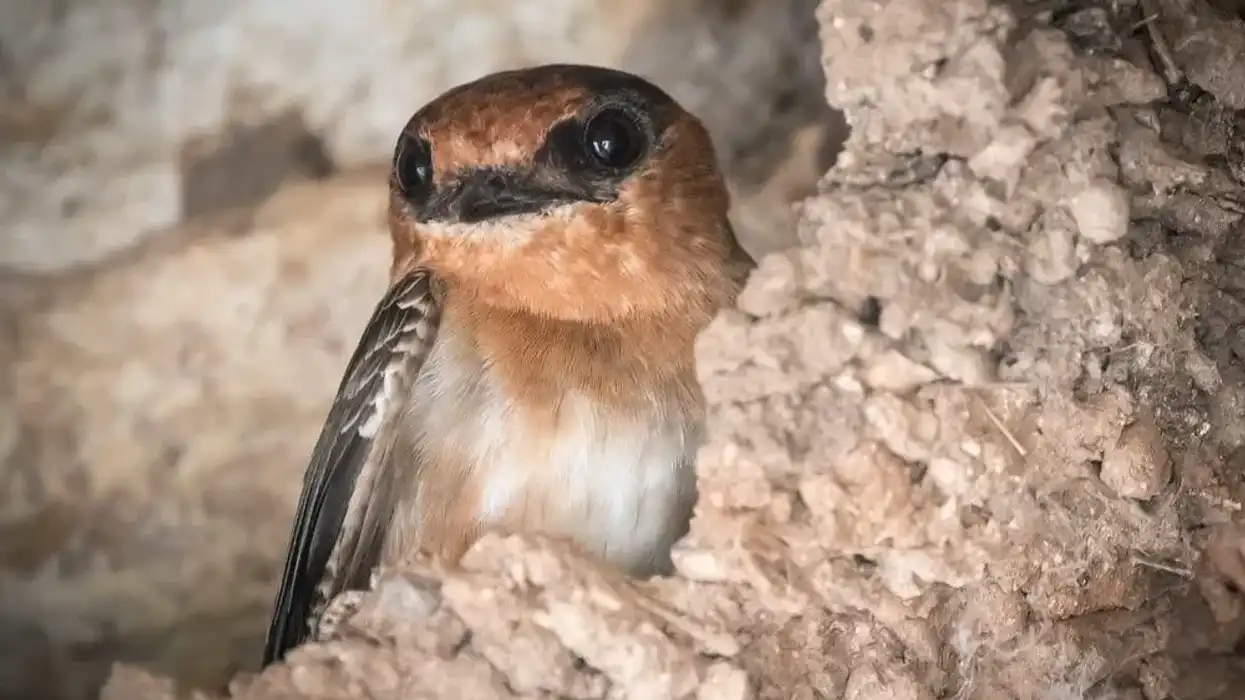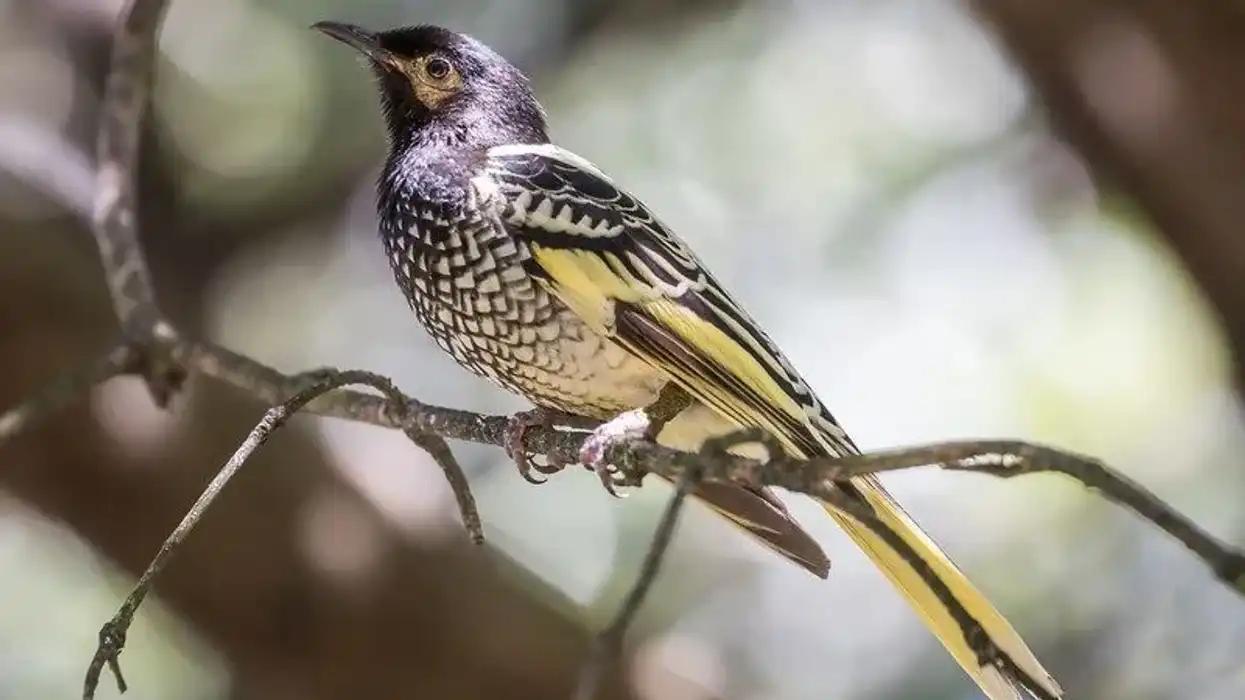Blue carmine bee-eaters are an inhabitant of the sub-equatorial wildlife of Africa. Even though they mainly belong to wildlife habitats, these birds are also kept in the zoo for visitors and act as insect controls.
Being monogamous in nature, these birds live in pairs mostly. They are known to behave very differently during the breeding season when they are in search of a shelter. Right before laying the eggs, they are observed to fly in a rapid motion in search of a place from nest to nest in the colonies.
They usually feed on insects and invertebrates for nutrition. After the birth of the chicks, both parents feed the babies. Father bee-eaters take care of the babies more than the mothers.
These birds have an elongated tail streamer with a body that is a mixture of carmine, black, and blue. The entire color distribution makes them a treat to visitors when these birds are seen in flight in flocks.
For more relatable content, check out these willet facts and great-tailed grackle facts for kids.
Carmine Bee-Eater Interesting Facts
What type of animal is a carmine bee-eater?
The carmine bee-eater is a bird. It belongs to the family of bee-eaters, Meropidae.
What class of animal does a carmine bee-eater belong to?
Both the southern carmine bee-eater(Merops nubicoides) and the northern carmine bee-eater (Merops nubicus) belong to the Aves class of animals. Residing in colonies near the humid equatorial belt, these colorful insectivores are a delight to the eyes of visitors.
How many carmine bee-eaters are there in the world?
According to the data from the International Union for Conservation of Nature (IUCN), the populations of both the southern carmine bee-eater and northern carmine-bee eater are not known. Their populations seem to be common around their ranges, but both have a declining trend.
Where does a carmine bee-eater live?
The location of both the southern carmine bee-eater and northern Carmine bee-eater (Merops nubicus) varies to a certain wildlife range even though they live in the same climatic zones. The northern Carmine bee-eater is restricted in countries like Benin, Central African Republic, Ghana, Tanzania, Burundi, and Uganda.
While the southern carmine bee-eater is found in places like KwaZulu-Natal and Namibia to Gabon, the eastern Democratic Republic of the Congo, and Kenya.
What is a carmine bee-eater’s habitat?
The southern carmine bee-eater and the northern carmine bee-eater (Merops nubicus) have the same wildlife habitat. They reside in and around the range of sub-tropical belts of Africa. Even though they are not majorly migratory in nature, they migrate only during the breeding season to different parts of Africa.
Who doe carmine bee-eaters live with?
This blue carmine species are monogamous in nature. They mostly live in pairs in colonies of flocks of these birds in the sub-equatorial belts of Africa.
How long does a carmine bee-eater live?
These birds of the world have an average lifespan of seven years while living in the wild. At times, their lifespan might extend to 10-12 years.
How do they reproduce?
Carmine bee-eaters are generally monogamous in nature. These birds of the world live in pairs and migrate within the sub-equatorial zones in search of a suitable place for the gestation period. The southern and northern carmine bee-eater tend to breed during the months of July to September.
They do not build their own nest and generally find a pre-built nest on the perch. The female removes the eggs of the original birds.
Their incubation period lasts up to 20-21 days ending in laying two to five eggs. During the gestation period, the female spends more time with the eggs in the nest on the perch of the trees.
What is their conservation status?
According to the International Union for Conservation of Nature (IUCN), this carmine-blue species is listed in the category of Least Concern. Even though the populations of southern and northern carmine bee-eater birds are common at the moment, there has been a decreasing trend in their population.
The major cause behind this would be the caretaker of bee-hives who finds these birds a threat to beehives.
Carmine Bee-Eater Fun Facts
What do carmine bee-eaters look like?
These colorful birds of the world are extremely vibrant and attractive birds of the sub-equatorial belts. Their body is mostly covered in carmine-colored feathers. The birds have red and pink upper wings. The face and the legs light blue in color while the beak is black in color.
How cute are they?
Needless to say, this species is extremely cute and beautiful by appearance. The carmine-blue-black color combination of its body makes it easy for this male species to attract females during the breeding season.
How do they communicate?
Bee-eaters have a unique way of communicating with each other. During their flight, they make an 'un-bee-eater-like' sound. In case of danger, they have a short call of 'tunk', 'terk', 'klunk' or 'chung' to alarm others. While mating during the breeding season, they give a loud call of 'rik-rik-rik-rak' to attract the attention of their partners.
How big is a carmine bee-eater?
The northern carmine bee-eater (Merops nubicus) does not have a very large body by size. This species has an average length of 9.4-10.6 in (24-27 cm). Even though they are not very large, they are larger in size than little bee-eaters who measure 6-6.7 in (15-17 cm) and are fairly small in length.
How fast can a carmine bee-eater fly?
Even though the exact wingspan is not known, the nubicoides and nubicus both are known to fly in a straight manner without many distractions. They swiftly take off from the perch in search of food and a nest.
How much does a carmine bee-eater weigh?
This species has a light-weighted body with an average weight of 1.5-2.1 oz (44-60 g).
What are the male and female names of the species?
The males of this species are called cocks and females of this species are called hens.
What would you call a baby carmine bee-eater?
A baby bee-eater is generally known as a chick.
What do they eat?
The nubicoides and nubicus both are insectivores by nature. They mostly feed on flying insects and invertebrates found in colonies like dragonflies, bees, termites, and locusts. Also, they enjoy eating bees, wasps, and hornets.
Are they predators?
They mostly feed on insects. This species can be termed as a predator in terms of hunting insects.
Would they make a good pet?
Even though these carmine-blue birds of the world are a member of wildlife, they are known to live in captivity. The birds are usually kept in the zoo for visitors as well as to keep a check on the population of insects.
Did you know...
These birds belonging to different ranges of Africa have a unique way of preying. They prey on flying insects and bring them to the perch. The insects are hit multiple times on the bark before being eaten by the birds.
How smart are carmine bee-eaters?
The nubicoides and nubicus are an extremely smart species of wildlife. During the breeding period to lay eggs, female birds remove the eggs of the original inhabitant of the nest that they inhabit as their own.
How high can they fly?
The African-based insectivores are mostly aerial by nature. Their flight is mostly at a higher altitude and in a straight manner. They have a swift flight and can change directions at any speed, but exactly how high they fly is not known.
Here at Kidadl, we have carefully created lots of interesting family-friendly animal facts for everyone to discover! Learn more about some other birds from our tricolored heron facts and Goliath heron facts pages.
You can even occupy yourself at home by coloring in one of our free printable carmine bee eater coloring pages.









